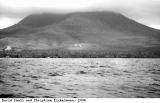John Pinney and his slaves
John Pinney’s plantation on the Caribbean island of Jamaica was called ‘Mountravers’ and is pictured here. Pinney felt that the need for slaves was very important. He described them as the ‘sinews’ of the plantation, meaning that they were the very life of it. He wrote that ‘it is as impossible for a man to make sugar without the assistance of negroes as to make bricks without straw’, because slaves were the best available labour force for the plantations. Pinney, unlike some plantation owners, believed in not working his slaves to death. He took this position not just out of fairness, but because he realised that a steady amount of work was more efficient than over-work. This only led to ill-health and less productivity. As well as not over-working them, Pinney provided some medical care for his slaves. Land was set aside for them to use for growing their own food. Presents of clothing were given as encouragement. He ordered that one of his managers should not treat the slaves harshly. He said that the manager ‘must not use severity, for I will not suffer any human being, committed by providence to my care, to be treated with cruelty’.
Such sentiment was partly due to Pinney’s recognition that more and more people in Britain were finding the cruelties of the slave plantations upsetting. However, although some slave owners were less cruel than others, nearly all were obsessed by the need to keep slaves from stealing their property, running away or rising up in rebellion . So even the most mild-tempered slave owner would use physical punishment as part of plantation discipline. It was common practice to give the job of disciplining the slaves to poorly educated white plantation workers (called overseers ). In law, the slave was seen as property rather than a human being. It was therefore common for slaves to be subjected to severe physical punishment. Pinney himself took care that some of his more tender-hearted visitors to his plantation never saw the beating of slaves.
Indeed, Pinney prepared for the visit of Tom Wedgwood in 1800 (the son of the porcelain manufacturer and anti-slavery campaigner, Josiah Wedgwoood). He instructed his manager not to allow ‘a negro to be corrected in his presence, or so near for him to hear the whip [and to]…point out the comforts the negroes enjoy beyond the poor in this country…show him the property they possess…by this means he will leave the island possessed with favourable sentiments’. Pinney wanted to show those who were against slavery how well the slaves were treated on his plantation. He wanted people to believe that the slaves were better off on his plantation than they were in their homeland of Africa. He also wanted people to see that the slaves were treated better than the industrial workers at home in Britain. This was because Pinney felt that if his visitors saw the slaves treated cruelly, they would be even more determined to campaign for an end to slavery. That would have meant the end of a profitable plantation for the likes of Pinney.




